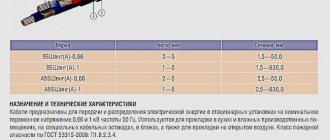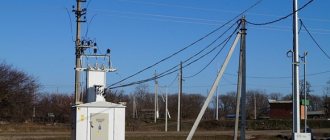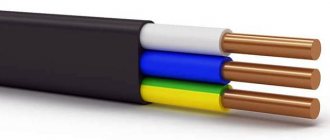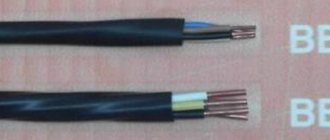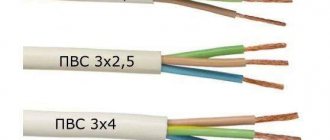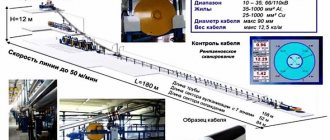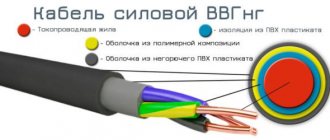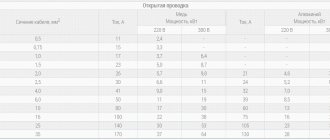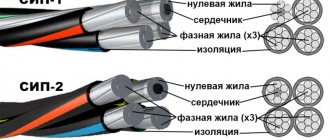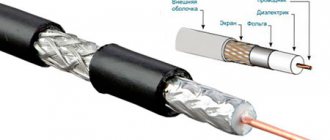Caring for people's health and understanding the need for a high level of safety, the state periodically reviews technical standards and regulations for the use of cable products. This is especially true for the installation and operation of electrical networks in crowded places, children's institutions, etc. Therefore, the “Technical Regulations on Fire Safety Requirements” recommends the use of low-toxicity LTx cables for the installation of power lines in buildings/structures with large human traffic or premises for a specific purpose.
LTx cable application
According to GOST 31565-2012, Table 2 (see below), it is necessary to lay cable and wire products with the indices ng -LTx in all educational, including children's, institutions, hospitals and other crowded and heavily visited facilities in order to maximally protect people in the event of a force emergency. major.
The predominant area of application of cables in GOST 31565-2012 is referred to by all design companies and supervisory authorities during the development and verification of the project.
Use of LTX cable.
The areas in which this or that cable is used are strictly regulated by GOST 31565-2012 “Cable products. Fire safety requirements."
According to this document, a cable with the abbreviation LTX must be laid in places with slow evacuation. These include: institutions with frequent and long-term stays of children, the elderly, disabled people and other sedentary people - schools, kindergartens, nursing homes, hospitals, boarding schools, sanatoriums, buildings in camps, hotels, as well as places where large numbers of people gather, stadiums , sports facilities and others.
Which cable is better LTx or HF, LS?
All ltx cables have a fire safety indicator such as the toxicity of polymer materials products (PTPM) or an equivalent indicator of the toxicity of combustion products of the product. This means that the toxicity value of the raw materials used in the production of the LTX cable must be greater than 120 g/m3. This indicator was calculated empirically: it has been proven that ignition of >120 g of materials from which the product is made per 1 m3 results in the release of harmful products that are fatal to 50% of living organisms.
The amount of toxicity is the main difference from the point of view of safety standards (see Fig. 1) of the varieties of Ltx, HF, LS cables. For products marked -FRHF, -FRLS this figure exceeds 40 g/m3, for LTx conductors - 120 g/m3.
Fig.1
Cable design VVGng(A)-LSLTx
The components of the product are several elements, the raw materials for which were materials of different properties.
- Lived. Made from high quality copper. It may consist of a single wire or be multi-wire. ITS shape is not the same type and can be either sectorial or round. Belongs to class 1 or 2.
- Insulation. PVC plastic, characterized by low fire hazard rates.
- Filling. PVC plastic, characterized by low fire hazard rates.
- Shell. PVC plastic, characterized by low fire hazard rates.
Is it possible to use -HF cable instead of LTx
According to GOST 31565-2012, cable brands with -HF have a fire hazard class P(x).8.1.2.1, and cables with the index -LTx - P(x).8.2.1.2. Each digit of the fire safety class indicates a certain fire safety indicator (Fig. 2) and a criterion for its evaluation. If you thoroughly analyze each number of the indicated classes, it turns out that LTX cables, in comparison with -HF brands, are worse in terms of corrosion activity and smoke formation, but better in terms of toxicity. For schools, kindergartens and other social facilities, the toxicity indicator is a priority when choosing a cable. Therefore, replacing LSLtx cables with -HF cables is not possible for these institutions; replacement with even safer brands from the -HFLTx series is acceptable.
Fig.2
There is an opinion, which is often voiced on various online forums, that these standards for the use of low-toxic LTx are not at all mandatory, but are recommended by the state. As an example, they cite the requirements of clause 4.1 of SP 6.13130.2009, which allow for the installation of fire alarm systems and other systems in public social premises to select cables/wires marked ng-FRLS/HF.
Characteristics of the LTX cable.
The addition to the LTX (low toxic) marking means low toxicity during combustion. This abbreviation was first introduced in 2009 GOST R 53315-2009 “Cable products. Fire safety requirements", today this GOST has been canceled, and GOST 31565-2012 is used instead. Cables are classified according to fire safety indicators. Conductors marked LTX belong to the PTPM1 class, which means that the toxicity level of the material of each element in the LTX cable design exceeds 120 g/m3 (GOST 12.1.044-Fire and explosion hazard of substances and materials). The indicator suggests that the amount of material only over 120 g, closed in a space of 1 m3, in the event of combustion, will release products that can lead to the death of 50% of living organisms. This indicator is also the main difference from cables such as LS, FRLS, HF, which have a toxicity level of over 40 g/m3.
The insulation of LTX type cables is made of non-toxic PVC plastic with reduced fire hazard.
ltx cable - review of brands of power, control, optical cables and their manufacturers
| Power | Tests | For fire alarm | Optical cables | twisted pair |
| VVGng(A)-LSLTx | KVVGng(A)-LSLTx | KPVSVng(A)-FRLSLTx | OKGMng-(FR)(HF)LSLtx | ParLan U/UTP Cat5e PVCLS ng(A)-LSLTx |
| VVGng(A)-FRLSLTx | KVVGng(A)-FRLSLTx | KPVSEVng(A)-FRLSLTx | OKGTsng-(FR)(HF)LSLtx | ParLan F/UTP Cat5e PVCLS ng(A)-LSLTx |
| VVGEng(A)-LSLTx | KVVGEng(A)-LSLTx | KPGVSVng(A)-FRLSLTx | OKKMng-(FR)(HF)LSLtx | ParLan SF/UTP Cat5e PVCLS ng(A)-LSLTx |
| VVGEng(A)-FRLSLTx | KVVGEng(A)-FRLSLTx | KPGVSEVng(A)-FRLSLTx | OKKtsng-(FR)(HF)LSLtx | |
| VBShVng(A)-LSLTx | OKTMng-(FR)(HF)LSLtx | |||
| VBShVng(A)-FRLSLTx | OKTsng-(FR)(HF)LSLtx | |||
| TsOS-ng(A)-FRHFLTx | ||||
| OBR-U-D-ng(A)-FRHFLTx. |
LTX cables are quite specific products that are not produced at every cable factory. Today there are quite a lot of manufacturers of ltx power and control cables: Elektrokabel Kolchugino, Avangard, Tsvetlit, NPP Kromkabel, Energokabel plant and others. The leaders in the production of ltx cables for fire alarms are Spetskabel, SPKB Techno, Kabel Elektrosvyaz plant and others. LTX optical cables can be found in the lines of Moskabel-Fujikura and Incab factories. Twisted pair cable in ltx version is produced by the Russian manufacturer TDP Paritet.
Application of VVGng(A)-LSLTx cable
The purpose of the VVGng(A)-LSLTx cable is standard. It consists of ensuring the transmission of electricity and its distribution in various equipment that is of a stationary type. Alternating current - up to a thousand volts. Frequency – up to fifty Hertz. Direct current - up to one and a half thousand volts.
This type of product is used for installation in public buildings belonging to fire safety classes F1 - F3. Such structures include:
- preschool and school institutions for children;
- boarding schools, orphanages, shelters, rehabilitation centers;
- homes for the disabled and elderly;
- sanatoriums, hospitals, hospitals, rest homes, boarding houses;
- hotels and motels, campsites, hostels;
- clubs, entertainment centers, gyms;
- buildings for housing public organizations;
- subways.
The products are often used in various systems at nuclear power plants of the second, third and fourth classes.
— price list, current prices, buy from stock and to order, delivery throughout the Russian Federation
What does the LTx index mean?
The abbreviation LTx stands for Low Toxic, that is, low toxic or with reduced toxicity. The LTx marking is being introduced for the first time in GOST R 53315-2009 “Cable products. Fire safety requirements." In accordance with the cable classification according to fire hazard indicators, LTx cables must comply with class PTPM1, in which the toxicity index of each material used in the LTx cable must be more than 120 g/m3 (GOST 12.1.044-Fire and explosion hazard of substances and materials). In accordance with the method for determining the indicator, this means that only over 120 g of material confined in a space of 1 m3 during combustion releases products that cause the death of 50% of organisms.
Cable insulation is made of low-toxic polyvinyl chloride plastic with reduced fire hazard.
LTx cables are intended for use in cable structures and premises, including residential and public buildings, buildings of preschool educational institutions, specialized homes for the elderly and disabled, hospitals, dormitory buildings of boarding educational institutions and child care institutions, hotels, dormitories, dormitories buildings of sanatoriums and general holiday homes, campsites, motels, boarding houses, as well as for entertainment, club, sports facilities, buildings of public service organizations, subways.
Distinctive features of fire alarm cables
The main role of maintaining the operability of fire alarm cables (fire-resistant) in fire conditions is ensured by the use of ceramic-forming silicone rubber as insulation.
At high temperatures that occur during a fire, the resulting silicon dioxide remains on the conductor in the form of an electrical insulating layer. Thanks to this property, the cable continues to conduct electric current in fire conditions.
Cable products for the installation of fire protection systems have a number of undeniable advantages. These cables:
- do not spread fire when laid in groups;
- have a high level of fire resistance;
- have low oxidative activity;
- emit minimal amounts of smoke and combustion gases;
- during a fire, they remain operational for 30–180 minutes (depending on the brand).
Thanks to these qualities, fire-resistant cables remain operational for a long time - sufficient to evacuate people even from large multi-storey buildings.
Basic fire safety requirements for fire cables
With the adoption of Law No. 123-FZ, the requirements for cable and wire products have become significantly stricter. Now any fire protection cable must operate uninterruptedly until the evacuation process is completed. This property is designated by the FR index and indicates increased fire resistance of cable products. In this case, the index FE180 or FE240 is added to the cable designation, indicating the time during which the cable remains operational under conditions of exposure to flame. In addition, it is allowed to add the index E15, E30, E45, E60 or E90 through the fraction, indicating the fire resistance limit of the cable line.
The rules state that cables must have high fire safety. The structure of modern cable products contains shells and insulating layers made of polymers or plastic compounds, which ignite when exposed to flame. The challenge for manufacturers is to provide wires and cables with self-extinguishing properties when the open flame source is removed. This parameter is marked with the index “ng”.
In addition, fire protection cables must not pose a risk to human health. Cables that emit a minimum amount of smoke are designated with the LS (Low Smoke) index, cables with low oxidative activity are marked HF (Halogen Free), A - category for flame retardation.
produces symmetrical fire alarm cables (KPS) in the “ng-FRLS” and “ng-FRHF”, “ng-FRLSLTx” versions, which do not lose their performance characteristics in the event of a fire. The compliance of fire-resistant cables with Russian GOST standards is confirmed by quality certificates and verified during bench tests.
JSC “ produces and sells alarm cables, which are intended for the installation of fire alarm systems, warning, evacuation and other fire protection systems. To buy a cable, call +7 (495) 221–89–93 or fill out the feedback form.
